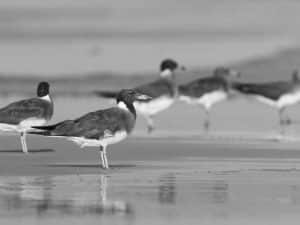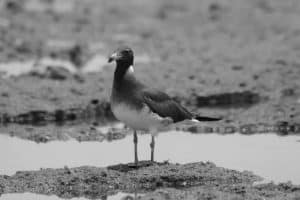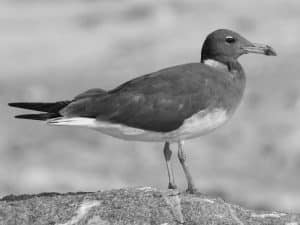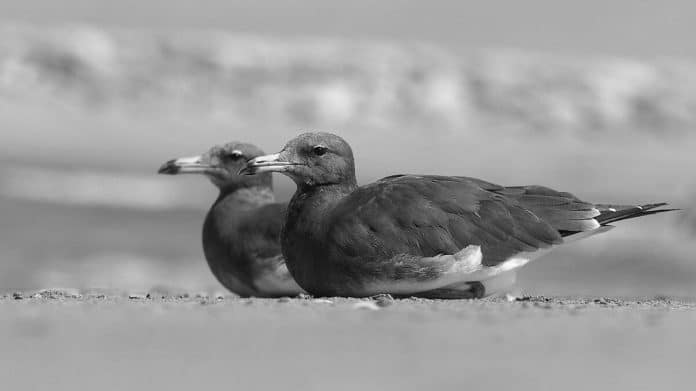Introduction to the Sooty Gull in Tanzania
Tanzania, a country known for its diverse and stunning wildlife, is home to a remarkable coastal avian species – the Sooty Gull. This elegant seabird, scientifically known as Larus hemprichii, is a captivating sight for birdwatchers and nature enthusiasts. Found along the shores of Tanzania’s expansive coastline, the Sooty Gull in Tanzania has become an emblem of the region’s natural beauty.
Habitat and Distribution of the Sooty Gull

The Sooty Gull is primarily found in coastal regions, making Tanzania’s sandy shores an ideal habitat for this magnificent bird. From the tranquil beaches of Zanzibar to the rugged cliffs of Mafia Island, the Sooty Gull can be spotted in various locations along Tanzania’s coastline. These birds are known to gather in large numbers on rocky outcrops and sandbars, creating a mesmerizing spectacle for those lucky enough to witness it.
Physical Characteristics of the Sooty Gull
With a wingspan of up to 130 centimeters, the Sooty Gull is an impressive sight in flight. Its plumage is predominantly dark gray, earning it the name “Sooty.” The bird has a white tail and underparts, which provide a striking contrast against its dark feathers. Its strong bill is yellow with a black tip, and its legs are a pale pink color. These physical characteristics make the Sooty Gull a distinctive and easily recognizable species.
Behavior and Feeding Habits of the Sooty Gull
The Sooty Gull is a highly adaptable seabird, capable of both diving and swimming. It feeds primarily on fish, squid, and crustaceans, which it hunts by plunging into the water from the air. These graceful birds are often seen soaring above the waves, scanning the water for their next meal. The Sooty Gull is also known to scavenge on beaches and in coastal towns, taking advantage of any available food sources.
Conservation Status and Threats to the Sooty Gull

While the Sooty Gull is not currently classified as a globally threatened species, its populations are declining in certain areas. The destruction of coastal habitats and pollution pose significant threats to these birds. Additionally, disturbance from human activities, such as tourism and fishing, can disrupt their breeding and feeding patterns. Conservation efforts are crucial to ensure the long-term survival of the Sooty Gull and other coastal avian species in Tanzania.
Unique Coastal Avian Species in Tanzania
Tanzania’s coastal regions are a treasure trove of avian diversity. Alongside the Sooty Gull, birdwatchers can spot an array of unique species. The African Fish Eagle, with its striking white head and powerful call, is a common sight along Tanzania’s rivers and lakes. The Pink-backed Pelican, with its vibrant pink plumage, is another fascinating bird found in Tanzania’s coastal wetlands. These and many other species make Tanzania a paradise for bird enthusiasts.
Best Locations for Birdwatching in Tanzania
For avid birdwatchers, Tanzania offers countless opportunities to observe and appreciate its coastal avian treasures. Saadani National Park, located on the coast, is a prime spot for sightings of the Sooty Gull and other seabirds. The wetlands of the Rufiji Delta, part of the Selous Game Reserve, are also rich in birdlife. In Zanzibar, the Jozani Forest is home to a variety of endemic bird species. These locations provide a unique and unforgettable birdwatching experience.
Tips for Birdwatching and Identifying the Sooty Gull
When embarking on a birdwatching adventure in Tanzania, it’s essential to come prepared. Binoculars and a field guide specific to African birds are invaluable tools for identifying the Sooty Gull and other avian species. Look for the distinctive dark gray plumage, white tail, and underparts, as well as the yellow bill with a black tip. Pay attention to the bird’s behavior, such as its diving and swimming abilities, to confirm its identity. Patience and keen observation skills are key to successful birdwatching in Tanzania.
Sooty Gull Research and Monitoring Projects in Tanzania

To better understand and protect the Sooty Gull population in Tanzania, various research and monitoring projects have been initiated. These projects aim to gather data on the species’ population size, breeding patterns, and feeding habits. By studying the Sooty Gull’s behavior and habitat requirements, researchers can develop effective conservation strategies. Community involvement and citizen science initiatives play a vital role in these projects, allowing local communities to contribute to the conservation efforts.
The Role of Community Engagement in Sooty Gull Conservation
Conservation of the Sooty Gull and other avian species in Tanzania relies heavily on community engagement. Local communities can play a crucial role in protecting the birds’ habitats and raising awareness about their conservation needs. By involving communities in monitoring and conservation projects, a sense of ownership and responsibility is fostered. This collaborative approach ensures the long-term sustainability of conservation efforts and helps secure a future for the Sooty Gull in Tanzania’s coastal ecosystem.
Conclusion
Tanzania’s coastal avian treasures, including the captivating Sooty Gull, offer a unique and awe-inspiring experience for birdwatchers. These elegant seabirds, with their distinct physical characteristics and fascinating behavior, are a testament to the country’s rich biodiversity. However, the conservation of the Sooty Gull and other coastal avian species requires collective efforts. By understanding their habitats, raising awareness, and engaging local communities, we can protect these avian treasures for generations to come. So, grab your binoculars, explore Tanzania’s coastal wonders, and witness the marvels of the Sooty Gull in its natural habitat.

































